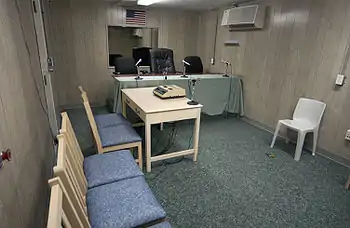| Yasin Qasem Muhammad Ismail | |
|---|---|
 | |
| Born | 1979 (age 43–44)[1][2] Ibb, Yemen |
| Detained at | Guantanamo |
| ISN | 522 |
| Charge(s) | no charge, held in extrajudicial detention |
| Status | transferred to the United Arab Emirates on January 19, 2017 |
Yasin Qasem Muhammad Ismail (Arabic: ياسين قاسم محمد إسماعيلي) is a Yemeni held in extrajudicial detention in the United States Guantanamo Bay detainment camps, in Cuba.[3] His Guantanamo Internment Serial Number is 522. Joint Task Force Guantanamo counter-terrorism analysts estimate he was born in 1979, in Ibb, Yemen.
Yasin Qasem Muhammad Ismail arrived in Guantanamo on May 20, 2002, and was held for nearly 15 years.[4][5][6] He was cleared for release in December 2016 and transferred to the United Arab Emirates in January 2017.[7]
Inconsistent identification
The Yemen Times reported, on March 11, 2007, that a Yemeni named Sadeq Mohammed Ismail, who was also born in Ibb, was on the list of Yemenis who had been cleared for release.[8] The official list does not include a captive named Sadeq Mohammed Ismail.[3] It does include two detainees whose names are near matches:
- Sadeq Muhammad Sa'id Ismail's name might be a closer match, but he is from Jabal Haimain, not Ibb.
- Yasin Qasem Muhammad Ismail is from Ibb, but his name is not as close a match.
Official status reviews
Originally the Bush Presidency asserted that captives apprehended in the "war on terror" were not covered by the Geneva Conventions, and could be held indefinitely, without charge, and without an open and transparent review of the justifications for their detention.[9] In 2004, the United States Supreme Court ruled, in Rasul v. Bush, that Guantanamo captives were entitled to being informed of the allegations justifying their detention, and were entitled to try to refute them.
Office for the Administrative Review of Detained Enemy Combatants

Following the Supreme Court's ruling the Department of Defense set up the Office for the Administrative Review of Detained Enemy Combatants.[9][12]
Scholars at the Brookings Institution, led by Benjamin Wittes, listed the captives still held in Guantanamo in December 2008, according to whether their detention was justified by certain common allegations:[13]
- Yasin Qasem Muhammad Ismail was listed as one of the captives who "The military alleges ... are associated with Al Qaeda."[13]
- Yasin Qasem Muhammad Ismail was listed as one of the captives who "The military alleges that the following detainees stayed in Al Qaeda, Taliban or other guest- or safehouses."[13]
- Yasin Qasem Muhammad Ismail was listed as one of the captives who "The military alleges ... took military or terrorist training in Afghanistan."[13]
- Yasin Qasem Muhammad Ismail was listed as one of the captives who "The military alleges ... were at Tora Bora."[13]
- Yasin Qasem Muhammad Ismail was listed as one of the captives whose "names or aliases were found on material seized in raids on Al Qaeda safehouses and facilities."[13]
- Yasin Qasem Muhammad Ismail was listed as one of the captives who was a foreign fighter.[13]
- Yasin Qasem Muhammad Ismail was listed as one of the captives who "deny affiliation with Al Qaeda or the Taliban yet admit facts that, under the broad authority the laws of war give armed parties to detain the enemy, offer the government ample legal justification for its detention decisions."[13]
- Yasin Qasem Muhammad Ismail was listed as one of the captives who had admitted "to training at Al Qaeda or Taliban camps".[13]
Ismail chose to participate in his Combatant Status Review Tribunal.[14]
During Ismail's first statement to his Combatant Status Review Tribunal he wrote: "I will talk with you as long as you guarantee me there will be no torture." Ismail said his prior confessions were lies - just to get the torture to stop.
Habeas corpus petition
Ismail had a writ of habeas corpus submitted on his behalf.[6] After years of delay it was turned down in 2010.
Formerly secret Joint Task Force Guantanamo assessment
On April 25, 2011, whistleblower organization WikiLeaks published formerly secret assessments drafted by Joint Task Force Guantanamo analysts.[15][16] His 12-page Joint Task Force Guantanamo assessment was drafted on November 10, 2008.[17] It was signed by camp commandant Rear Admiral David M. Thomas Jr. He recommended continued detention.
Incident of January 7, 2009
On February 23, 2009, the Christian Science Monitor reported on an incident that occurred on January 7, 2009, where camp authorities version conflicted with that of Ismail.[18] Both camp authorities and Ismail agree that during his exercise period Ismail requested he be moved from his exercise pen, into a nearby empty exercise pen that was exposed to the Sun. He was told, "You are not allowed to see the Sun." According to David Remes, one of Ismail's lawyers, Ismail and his guards engaged in an angry dispute, and a frustrated Ismail, who had not seen the Sun in a month, took off one of his sandals, and threw it at the pen's fence near his guards.
According to Remes, Ismail was left in the exercise pen for hours, until night fell, and he fell asleep.[18] He was woken to find himself being beaten by the camp's "immediate reaction force". Remes said that Ismail told him the immediate reaction force not only shackled him, and beat him, but that they choked him, and then one of the guards urinated on his head. He told Remes that after he was returned to his cell, when he woke the next morning he was bleeding from his ear.
Camp Commandant David M. Thomas claimed Ismail's version was a "complete and total fabrication".[18] According to camp authorities, Ismail had not only thrown his sandal, but he had thrown a book, and he had spit on the guards. Camp authorities characterized the alleged spitting as an "assault".
Camp authorities claimed that the immediate reaction force's extraction was "passive in nature and used the minimum amount of force necessary."[18] They further claimed that the incident had been videotaped, and that Ismail was given a medical examination afterwards, which found no wounds.
However, the Christian Science Monitor noted that camp authorities had refused to release the videotape, or any of Ismail's medical records, including the report from the medical examination camp authorities had asserted showed he had not been wounded.[18]
June 2009 sit-in
Carol Rosenberg, writing for the Miami Herald, reported that Yasin Qasem Ismail participated in a protracted sit-in.[19] Captives' attorney, like Yasin's attorney David Remes, were aware of the sit-in, but were not allowed to tell reporters without violating their classification agreement. Rosenberg said the sit-in involved approximately half the captives held in Camp 5. The captives refused to leave their exercise yard, and in contrast to previous confrontations with the camp authorities, they decided to wait out the protesters, rather than resort to violence.
The sit-in was triggered by increased security measures following the June 1, 2009, apparent suicide of Muhammed Ahmad Abdallah Salih.[19]
Hunger striker
Ismail was a long term hunger striker.[20] In 2013, the Yemen Times quoted him describing the manner of the force-feeding of the hunger strikers as inhumane.
References
- ↑ "Recommendation for Continued Detention Under DoD Control (CD) for Guantanamo Detainee , ISN: US9YM-000522DP (S)" (PDF). Retrieved 2023-09-03.
- ↑ "Guantanamo Detainee Profile" (PDF). Retrieved 2023-09-03.
- 1 2
OARDEC. "List of Individuals Detained by the Department of Defense at Guantanamo Bay, Cuba from January 2002 through May 15, 2006" (PDF). United States Department of Defense. Archived (PDF) from the original on 2007-09-30. Retrieved 2006-05-15.
 Works related to List of Individuals Detained by the Department of Defense at Guantanamo Bay, Cuba from January 2002 through May 15, 2006 at Wikisource
Works related to List of Individuals Detained by the Department of Defense at Guantanamo Bay, Cuba from January 2002 through May 15, 2006 at Wikisource
- ↑ "Measurements of Heights and Weights of Individuals Detained by the Department of Defense at Guantanamo Bay, Cuba (ordered and consolidated version)" (PDF). Center for the Study of Human Rights in the Americas, from DoD data. Archived from the original (PDF) on 2010-06-13.
- ↑ Margot Williams (2008-11-03). "Guantanamo Docket: Yasin Qasem Muhammad Ismail". New York Times. Retrieved 2016-12-11.
- 1 2
Andy Worthington (2016-12-17). "Periodic Review Boards Approve Another Two Yemenis for Release from Guantánamo". Retrieved 2016-12-17.
Another low-level foot soldier, Ismail had his habeas corpus petition turned down in April 2010, a decision that was upheld on appeal a year later, but to be honest there was nothing about his case to suggest that he actually constituted any kind of threat to the US.
- ↑ Savage, Charlie (19 January 2017). "Obama Transfers 4 From Guantánamo, Leaving 41 There as Term Ends". The New York Times.
- ↑ Amel Al-Ariqi (March 11, 2007). "Yemeni detainees are the largest group at Guantánamo". Yemen Times. Archived from the original on 2007-09-29. Retrieved 2007-03-15.
- 1 2
"U.S. military reviews 'enemy combatant' use". USA Today. 2007-10-11. Archived from the original on 2007-10-23.
Critics called it an overdue acknowledgment that the so-called Combatant Status Review Tribunals are unfairly geared toward labeling detainees the enemy, even when they pose little danger. Simply redoing the tribunals won't fix the problem, they said, because the system still allows coerced evidence and denies detainees legal representation.
- ↑ Guantánamo Prisoners Getting Their Day, but Hardly in Court, New York Times, November 11, 2004 - mirror Archived 2007-09-30 at the Wayback Machine
- ↑ Inside the Guantánamo Bay hearings: Barbarian "Justice" dispensed by KGB-style "military tribunals", Financial Times, December 11, 2004
- ↑ "Q&A: What next for Guantanamo prisoners?". BBC News. 2002-01-21. Archived from the original on 23 November 2008. Retrieved 2008-11-24.
- 1 2 3 4 5 6 7 8 9 Benjamin Wittes (2008-12-16). "The Current Detainee Population of Guantánamo: An Empirical Study" (PDF). The Brookings Institution. Archived from the original (PDF) on 2013-06-01. Retrieved 2010-02-16.
- ↑ Summarized transcripts (.pdf), from Yasin Qasem Muhammad Ismail's Combatant Status Review Tribunal - pages 84-89
- ↑
Christopher Hope; Robert Winnett; Holly Watt; Heidi Blake (2011-04-27). "WikiLeaks: Guantanamo Bay terrorist secrets revealed -- Guantanamo Bay has been used to incarcerate dozens of terrorists who have admitted plotting terrifying attacks against the West – while imprisoning more than 150 totally innocent people, top-secret files disclose". The Telegraph (UK). Archived from the original on 2012-07-15. Retrieved 2012-07-13.
The Daily Telegraph, along with other newspapers including The Washington Post, today exposes America's own analysis of almost ten years of controversial interrogations on the world's most dangerous terrorists. This newspaper has been shown thousands of pages of top-secret files obtained by the WikiLeaks website.
- ↑ "WikiLeaks: The Guantánamo files database". The Telegraph (UK). 2011-04-27. Archived from the original on 2015-06-26. Retrieved 2012-07-10.
- ↑ "Yasin Qassem Muhammad Ismail: Guantanamo Bay detainee file on Yasin Qassem Muhammad Ismail, US9YM-000522DP, passed to the Telegraph by Wikileaks". The Telegraph (UK). 2011-04-27. Retrieved 2016-12-17.
- 1 2 3 4 5 Warren Richey (2009-02-23). "The case of the Guantánamo detainee who wanted to see the sun: Yasin Ismail's case highlights the difficulty of verifying conditions of confinement". Christian Science Monitor. Archived from the original on 2011-07-08. Retrieved 2009-02-23.
- 1 2 Carol Rosenberg (2009-07-14). "Strip searches sparked June Guantánamo sit-in". Miami Herald. Retrieved 2009-07-15.
- ↑
Sara Abdullah Hasan (2013-05-27). "The forgotten in Guantanamo". Yemen Times. Archived from the original on 2013-05-30. Retrieved 2016-12-17.
Yasin Ismaeel, one of the Yemeni detainees, commented on forcing feeding, saying: "I don't want to be fed like that. But if you're insisting, you should do it in a humanitarian way at least."